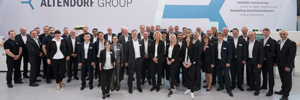Friday, June 28, 2019
 Altendorf’s “ASA” safety assistant captivates the users and the specialist press at LIGNA.
Altendorf’s “ASA” safety assistant captivates the users and the specialist press at LIGNA.
Exclusive new development employs three-stage system to prevent accidents
Nothing drew a crowd to the new Altendorf Group’s LIGNA stand like the demonstrations of the latest development for the Altendorf sliding table saw. Experts from all the over the world caught their breath as a member of the Altendorf Group’s development team moved a hand towards the saw blade at the speed of a normal feed rate – and suffered not so much as a scratch. The saw blade, a 400 mm disk spinning at about 5000 rpm, simply disappeared – all in a fraction of a second. The blade is braked to a standstill too, meaning that this safety system, unlike those of other manufacturers, works even with larger saw blades. The demonstrations at LIGNA left everyone who witnessed them thoroughly impressed: users, dealers and the international specialist press all left the stand confident that “ASA” (the working title of this ground-breaking safety development) just will not permit accidents at the sliding table saw. A three-stage system using a number of technical solutions ensures that caution and prevention prevail.
Keeping operators safe and sound
Karl-Friedrich Schröder, Head of Development at the Altendorf Group, explained to the 120 or so international trade partners present at the dealer evening how the pioneering project to develop ASA came about: “We have always been uneasy about the fact that existing systems, including the well-known “Saw Stop” feature, only ever kick in after the accident has happened. And they cause damage to parts of the machine as well. We wanted the machine to act sooner to protect the operator and prevent accidents and life-threatening injuries altogether. This means detecting the hazard at an early stage without impinging on the operator’s discretion. We developed a three-stage system to do just this. The first stage involves the machine emitting an optical signal. Stage two sees the rotational speed of the saw blade reduced, which greatly increases the resistance felt by the operator. This gains us valuable time – a valuable few tenths of a second – to prepare the system for stage three, in which the blade is brought to a standstill and the whole unit drops away into the table.”
Early hazard detection is critical
The Altendorf Group’s system relies on being able to detect the hazard at a very early stage. Various defined situations are recognised as parameters and classified using a number of cameras to gather data and a powerful computer to synchronise and interpret it. If the system detects a hazard situation, it responds as described by warning the user in two stages and then, in the third stage, removing the hazard altogether: the main saw blade stops very quickly and the whole saw unit rapidly drops away. Significantly, the saw can resume work immediately after the incident because the whole process – again in marked contrast to conventional solutions – involves no damage to either machine or saw blade: the prompt detection of potentially hazardous situations enables the saw blade to be braked and dropped in a controlled manner so that no additional stress is placed on the precision bearings of the saw unit.
The optical system also detects work gloves
Keeping our operators safe is an absolute priority for the Altendorf Group’s development engineers, so it should come as no surprise to learn that they were concerned from the outset to ensure the system was not fooled by work gloves. It soon became clear that optical detection techniques were more promising in this regard than sensor-based solutions. The camera systems used are designed to detect hazard situations irrespective of whether the user is wearing work gloves. This optical solution thus significantly exceeds the capabilities of sensor-based systems, which respond only to heat and human skin.
No material-based restrictions
The system copes readily with damp wood and conductive materials and coatings too; indeed it satisfies in full the development objective of ensuring machine operators are not restricted in any way in their use of the siding table saw. As Schröder explains, “At Altendorf, we know that the great majority of saw operators across the more than 130 countries in which our products are installed have no real specialist training. Our system can protect all of these people from injury, which is obviously good for them and their employers and also helps to eliminate both machine downtime and working time lost due to accidents.” How soon the system will be ready to go into full production depends on the many extensive national and international certification processes mandated by statutory accident insurers and governmental authorities. Technically, the system already works beautifully – as visitors at LIGNA could see very well for themselves. Having taken such great care developing the solution itself, however, the Altendorf Group has no intention of cutting corners on approval: operators deserve no less. The patent applications have been filed and the process is under way, which means realistically the system will not be available to buy before 2020.
Tags: "ASA" safety assistant, altendorf, Altendorf sliding table saw, Head of Development, Karl-Friedrich Schröder, LIGNA Stand, specialist press
Comments: